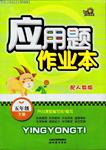题目内容
_________ sweet, the flowers in the botanic garden attract the visitor.
- A.Smelt
- B.To smell
- C.To be smelt
- D.Smelling

 应用题作业本系列答案
应用题作业本系列答案 暑假作业暑假快乐练西安出版社系列答案
暑假作业暑假快乐练西安出版社系列答案What would life be like without rich, creamy, mouthwatering, melt-in-your-mouth chocolate?
Life would be bitter for most Americans. They spend about $13 billion a year buying all sorts of chocolate treats.
However, for the African children who toil under slavelike conditions on cacao plantations, life is not sweet. The cacao bean is the main ingredient in the chocolate. According to a 2002 survey by the International Institute of Tropical Agriculture and the US Agency for International Development, about 284,000 children work in dangerous conditions on cacao farms in western Africa.
More than half those children are younger than 14. Many were sold into forced labor to work 12 hours or more a day on the cacao plantations.
A number of international organizations, including several African governments, recently began a program to eliminate(消除) child labor on cacao plantations. Under the program, government officials will remove children from abusive working situations while teaching farmers about child labor issues.
The program will also make borrowing money easier for cacao farmers. Officials hope farmers will use the money to invest in their farms and hire paid laborers.
【小题1】The cacao bean is the main ingredient in _______.
| A.treats |
| B.coffee |
| C.chocolate |
| D.cigarettes |
| A.About 284,000. |
| B.About 142,000. |
| C.About 467,000. |
| D.About 876,000. |
| A.cacao farms in western Africa rely heavily on child labor |
| B.children in Africa know how to make the best chocolate |
| C.candy bars sold in the United States are made on plantations in Africa |
| D.eating too much chocolate is bad for your health |
The house was quiet at 5 am and Tim’s mother was asleep. Only the sound of the big freezer broke the quiet. He’d dreamt of the cave last night. The purring(轻微颤动声)of the freezer had been the sea.
Tim pulled on a sweater and put some apples into his schoolbag. It was too early for breakfast. He’d eat after he’d been through the cave, sitting on the rocks and staring at the sea.
He wished he had a proper pack. His schoolbag would have to do. What else? Sandwiches—but his mother might wake up if he started pulling out bread for sandwiches. She’d want to know why he had to leave so early. He settled for some biscuits, and left a note stuck to the table:
Gone to Michael’s. Back tonight, Tim.
The sky was high and soft and light outside, though the sun still wasn’t up. Even the highway up the hill was quiet as he made his way down the street. The wind from the sea was fresh and sweet.
The sand hills still breathed heat from yesterday’s sun, though the top of the sand was cool. He ran down to the beach impatiently, but there was no one, just dry sand dancing in the early wind and seabirds marching up and down watching the waves.
The light changed suddenly. The first rays of sunlight stretched (延伸) across the sea. The sun was pushing its way over the edge of the world.
Over the first rocks, along to the point, Tim glanced back. The beach was still empty. The sun sailed higher in the sky.
He could see the cave now, even darker in the morning light. The sand turned silver then dark gold as the water flowed away from it. He had to force himself to go closer. Why was it so much more mysterious now? But it would be silly to go back now after so much trouble. He needn’t go in all the way...
【小题1】What did Tim do at the beginning of the story?
| A.He left the house quietly. | B.He had breakfast at home. |
| C.He left a note on the freezer. | D.He put a sweater in his schoolbag. |
| A.had to leave the biscuits on the table |
| B.liked biscuits better than sandwiches |
| C.had to take biscuits instead of sandwiches |
| D.could only find some biscuits in the kitchen |
| A.The height of the first rocks. | B.The ups and downs of the waves. |
| C.The change in the position of the sun. | D.The vast stretch of the sunlit beach. |
| A.The sea looked like a piece of gold. |
| B.Seabirds flew away when Tim arrived. |
| C.Tim was the only person on the beach. |
| D.The sky got dark as Tim reached the cave. |
| A.loneliness to craziness | B.anxiousness to excitement |
| C.helplessness to happiness | D.eagerness to nervousness |
What would life be like without rich, creamy, mouthwatering, melt-in-your-mouth chocolate?
Life would be bitter for most Americans. They spend about $13 billion a year buying all sorts of chocolate treats.
However, for the African children who toil under slavelike conditions on cacao plantations, life is not sweet. The cacao bean is the main ingredient in the chocolate. According to a 2002 survey by the International Institute of Tropical Agriculture and the US Agency for International Development, about 284,000 children work in dangerous conditions on cacao farms in western Africa.
More than half those children are younger than 14. Many were sold into forced labor to work 12 hours or more a day on the cacao plantations.
A number of international organizations, including several African governments, recently began a program to eliminate(消除) child labor on cacao plantations. Under the program, government officials will remove children from abusive working situations while teaching farmers about child labor issues.
The program will also make borrowing money easier for cacao farmers. Officials hope farmers will use the money to invest in their farms and hire paid laborers.
1.The cacao bean is the main ingredient in _______.
|
A.treats |
|
B.coffee |
|
C.chocolate |
|
D.cigarettes |
2.How many children under 14 work on cacao farms in western Africa?
|
A.About 284,000. |
|
B.About 142,000. |
|
C.About 467,000. |
|
D.About 876,000. |
3.From the passage, you can reasonably conclude that _______.
|
A.cacao farms in western Africa rely heavily on child labor |
|
B.children in Africa know how to make the best chocolate |
|
C.candy bars sold in the United States are made on plantations in Africa |
|
D.eating too much chocolate is bad for your health |